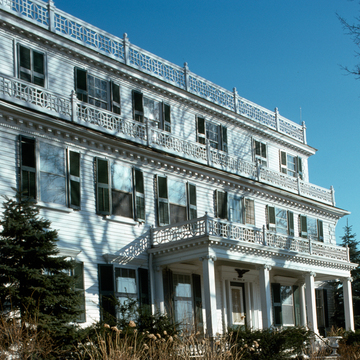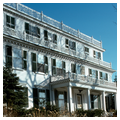The transitions from colonial to Federal to Greek Revival architecture were never as abrupt or jolting in Bristol as elsewhere, and in each style an invincible sense of local character remained, invariably classical in spirit, cubic in volume and exquisitely delicate in ornament. No house captures this continuity so naturally as the Bradford-Norris house. Built in 1792 for William Bradford, deputy governor of Rhode Island during the Revolution, the house was originally a boxy Federal affair. In the 1840s it passed to Francis Dimond and then to his daughter Isabel and her husband, Samuel Norris. Norris moved the house back from the line of the street and hired Russell Warren to remodel it.
By this point Warren was an accomplished Greek Revival architect, but in Bristol he preferred to practice in the indigenous wood vernacular in which he had been apprenticed. He transformed the block of the frame house with a series of elegant additions. Most extraordinary is the third story, which is recessed to form a continuous parapet. This is fronted with an elegant balustrade, whose geometric forms are reiterated in matching balustrades along the roof and also above the Ionic entrance porch. The detail is Chippendale, but of a chinoiserie sensibility and with the delicacy of fine cabinetry, which suggests the cosmopolitan outlook of an international port.





















